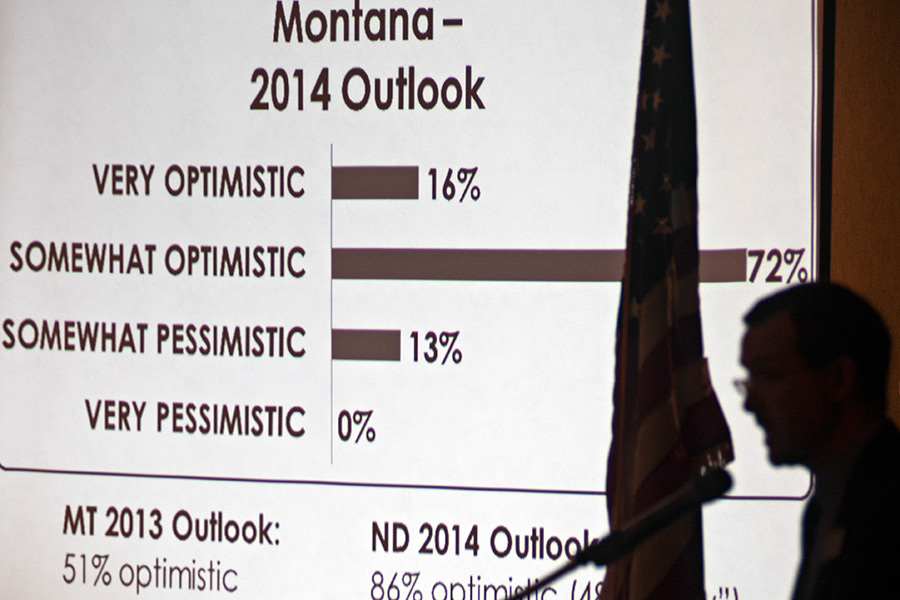Five years after the recession, the critical impact of the massive economic downturn still reverberates in many pockets of the U.S. Recovery is occurring, but in some areas, including Montana, it’s trending at a slow, steady pace instead of a fierce rebound. Optimism exists, but so does uncertainty, particularly in light of ongoing changes involving health care reform and proposed environmental regulations that could affect a portion of the nation’s energy sector.
The U.S. economy, hampered by contraction in the first quarter and buoyed by strong growth in the second, has only grown at a 1 percent pace in the first half of 2014. In Montana, updated economic data show the state’s growth was slower than previously thought, illustrating a modest recovery. Total non-farm earnings rose 2.2 percent last year, inhibited by government contraction and softening commodity prices.
At the national level, the housing market has underperformed but job growth and consumer spending, especially auto sales, continue to be bright spots. The Associated Press reported last week that average job gains over the past six months reached 244,000 in July, the best such monthly average in eight years.
Among industry growth, manufacturing has made robust gains, both nationwide and in Montana.
So why the slow overall growth?
“That’s the great mystery,” said Patrick Barkey, director of the University of Montana’s Bureau of Business and Economic Research.
Barkey was in Kalispell last week for the Mid-Year Economic Update, a follow-up to the BBER’s annual forecast event held in late January.
The economist believes the slow economic recovery can be blamed on the labor market, which is creating a ripple effect negatively impacting housing starts and stalling other gains. That may seem unusual considering employment numbers have almost approached pre-recession levels and the jobless rate continues to drop, but Barkey noted that Americans are working lower-paying jobs than six years ago. There’s also a larger percentage of people working part-time jobs, according to Barkey, which leads to smaller incomes.
In the wake of the recession, 5 percent of the nation’s low-paying jobs were lost, as well as 8 percent of mid-paying jobs and 6 percent of high-paying jobs, Barkey said.
In the five years since, the job growth includes a 12 percent rise in low-paying jobs; 4 percent rise in mid-paying jobs; and 6 percent increase in high-paying jobs.
“The economy is not creating the kind of jobs with better incomes than before the recession,” he said. “This is the crux of the problem. We’re not growing in the right way.”
This low wage growth among Americans can be blamed for soft home construction and sales, which are key indicators of an economy’s vitality.
“It’s not because of interest rates. And it’s not because of credit or availability. It’s really tied up, if you ask me, with income. People need to have an income to buy a house,” Barkey said.
According to the Association Press, in July, average hourly earnings ticked up just a penny to $24.45, only 2 percent higher than 12 months earlier. That figure is lower than the current inflation of 2.1 percent. According to the AP, in a healthy economy, wages before inflation would rise 3.5 percent to 4 percent annually.
Despite the slow wage growth, home building is picking up in Montana, Barkey said. Flathead County is among the top areas in the state in terms of housing growth.
The Flathead has also performed near the top in terms of job growth, with more than 1,000 jobs created last year.
“Growth is accelerating. Flathead is moving in the right direction,” he said. “But it’s a deep hole. We’re not quite back where we’d like to be in terms of overall growth.”
Locally, the health care sector has seen the most growth. The wood products industry is “smaller and healthier,” Barkey said, and tourism and travel are experiencing durable growth.
Barkey predicted 2.4 percent earnings growth for 2014, slightly below the forecast he delivered earlier this year.
Optimism does exist, according to nationwide and statewide surveys. Roughly 74 percent of respondents to a recent business survey were hopeful that 2014 would see improvements to the nation’s economy, according to the Montana Chamber of Commerce.
The same survey showed a glaring dissatisfaction with partisan gridlock on Capitol Hill and concerns over health insurance costs and an unfavorable business climate, according to Glenn Oppel with the Chamber.
Oppel said Montana businesses are expressing cautiousness as the Affordable Care Act continues to unfold. The employer mandate is slated to take effect next year, and “I think a lot of employers are seeing uncertainty going into next year when it comes to health care,” Oppel said.
There are also the new regulations being proposed by the Environmental Protection Agency that would cut carbon-dioxide emissions for power plants by 30 percent by 2030, a landmark decision that follows President Barack Obama’s plan to curb global warming.
According to the Associated Press, three of the top 10 coal-producing states are in the West — Wyoming, Montana and Colorado. Montana’s 2,100-megawatt Colstrip plant is one of the largest in the West and faces an uncertain fate in the wake of any new regulations.
“How is that going to impact our coal development here in Montana?” Oppel said. “It’s going to be a big issue for us coming into this year and next year.”
